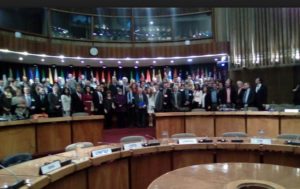What does the GCM mean?
 The Australian Government has indicated it may not sign the Global Compact on Migration – an historic agreement to promote safe and orderly migration and reduce human smuggling and trafficking.
The Australian Government has indicated it may not sign the Global Compact on Migration – an historic agreement to promote safe and orderly migration and reduce human smuggling and trafficking.
Australia argues the compact threatens “national sovereignty” even though the compact is non-binding on countries. And, the US and Hungary have already said they will not sign the compact.
So, what’s the compact, and the controversy, all about?
The first thing to know is that, unlike refugees, for migrants there are no specific global and regional protection conventions or comparable set of rules.
There is no world or United Natons migration organisation and no binding treaty for the protection of migrants against human rights breaches or exploitation.
The starting point for the Migration Compact – as with the Global Compact on Refugees, which is currently still being negotiated – was a summit on migration initiated by then US President Barack Obama and took place under the aegis of the UN in September 2016.
The compact is essentially a set of 23 goals that attempts to close this gap.
The text of the compact places particular focus on protection, the rights and improved living and working conditions of migrants and their families.
Combating the exploitation of labour, human trafficking and discrimination, as well as expanding the options for regular migration, also represent key elements of the compact.
The compact also calls for improved data management regarding international migration processes, promotes the tackling of economic, environment-related and political causes of forced migration and it enshrines the goal of “integrated, secure and coordinated” border management.
The underlying message of the agreement seems not to endorse uncontrolled mass immigration.
Instead, it acknowledges that migration is a global reality that cannot simply be halted by closing borders or spending cash on development aid.
The compact also argues that migration is actually a “source of global prosperity, innovation and sustainable development”.
An example of this is the $US466 billion in global remittances sent last year.
The compact is not binding. In principle, it is merely a declaration of intent.
One pillar of the agreement is to promote more “safe, orderly and regular migration” – as foreseen by the UN sustainability goals.
The compact recognises that a large proportion of international migration movement takes place within the regions of the Global South.
Migration from Africa to Europe represents just a small portion of the overall African migration. Two thirds of African migrants live in other African countries.
The compact also envisions an upgrading of the IOM – the UN’s migration agency – or the creation of a UN migration secretariat with a policy forming, not merely coordinating, function.
It argues this body is needed because international migration policy needs to be connected far more closely to development, climate and environmental policies, which can also influence migratory movements.
The compact also says regional organisations – such as cities or municipalities – which play a key role in the regulation of regional migration systems, need to be reinforced within the global migration architecture.
This is largely because in developing and emerging countries, in particular, they are the central locations and actors for the reception and integration of migrants.
The Global Compact for Safe, Orderly and Regular Migration is not legally binding. It will be formally adopted at a ministerial meeting in Marrakech, Morocco, on December 11 and 12.
Laurie Nowell
AMES Australia Senior Journalist












